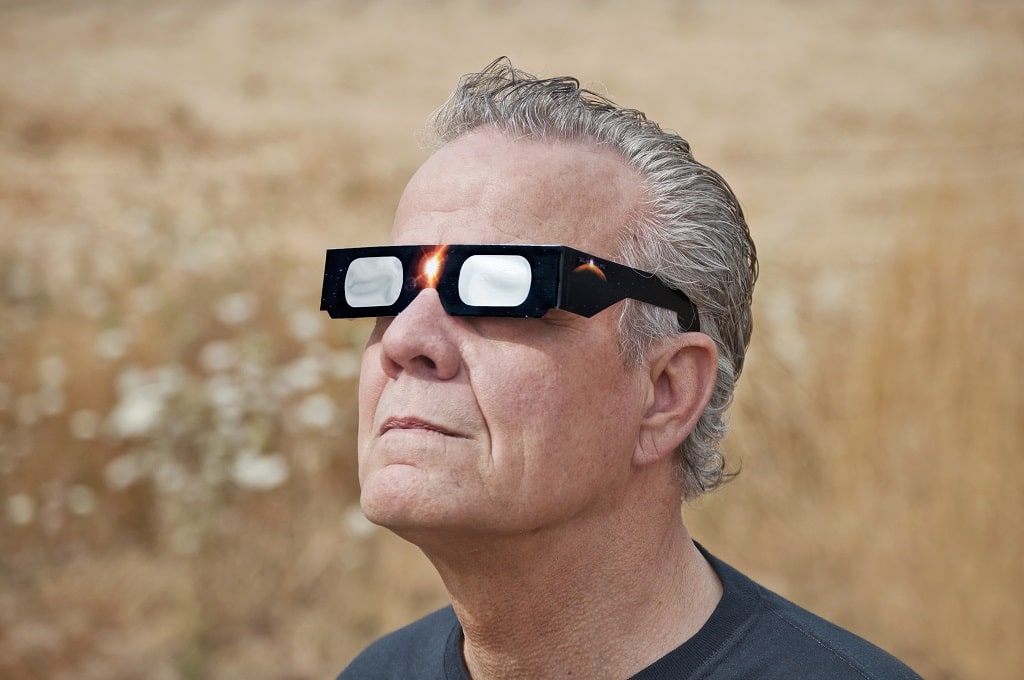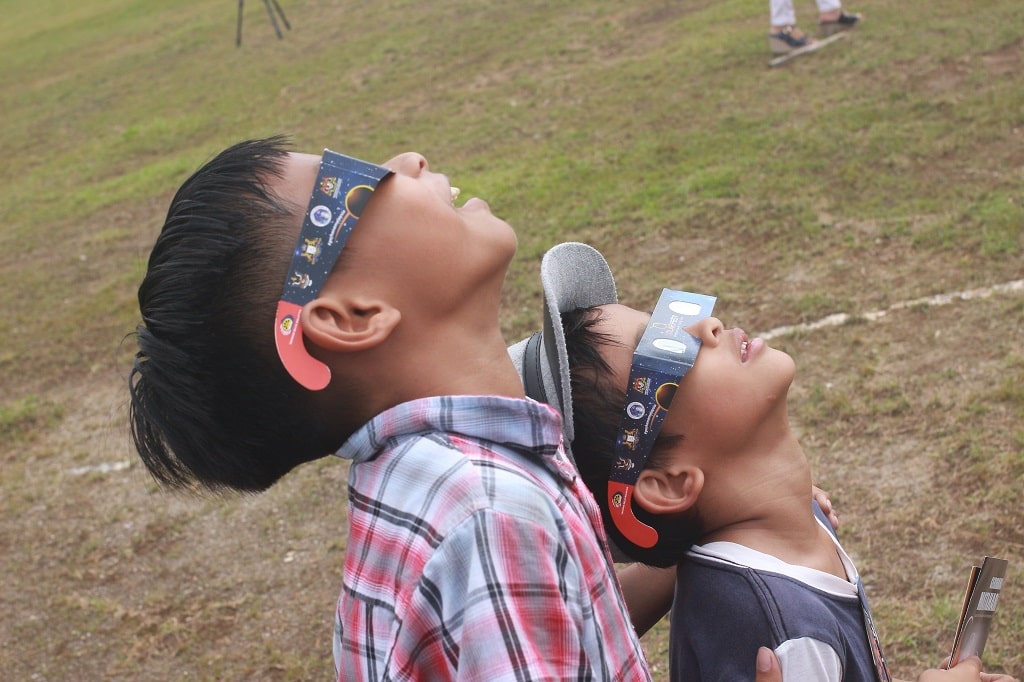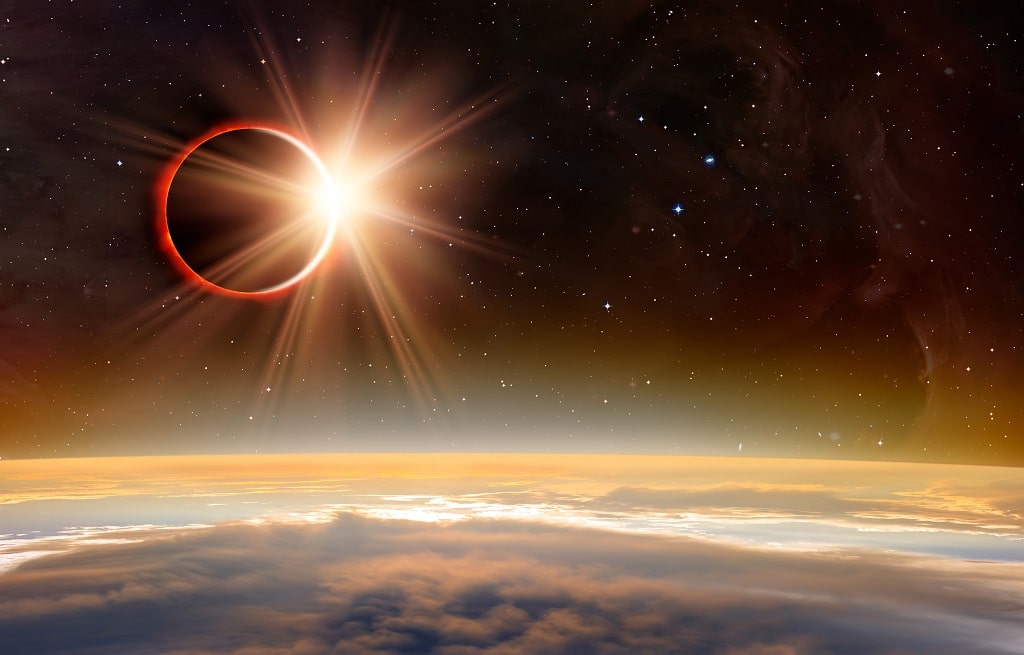
Updated: December 30, 2022
By now, you know to never look at the sun directly as it can hurt your eyes. In fact, doing so can even cause permanent damage to your eyes, including blindness. But as the solar cycle continues to ramp up, many people wonder about the safety of looking at a solar eclipse. Can you look at a solar eclipse safely without causing eye damage? Let’s explore this common question and learn about some important tips.

Can you look directly at a solar eclipse? If you take the right precautions, the answer is yes. We’ve been asked this question enough times that it’s appropriate to share the answer. Totality will last between two to three minutes, according to NASA. If you are at all unsure about whether the eclipse has reached totality, do not remove your glasses. Looking directly at the sun before it is completely blocked by the moon can cause significant damage to your retina. The retina is where visual information is formed. More specifically, the retina contains light-sensitive cells that pass information from the optic nerve to the brain. Because the sun is so much brighter during an eclipse, the potential for damage to your eyes is greater. Solar glasses should be worn at all times during the eclipse and should be applied and removed while looking away from the sun.
You might be wondering why can’t you look at a solar eclipse. In reality, it can potentially damage your eyes if you don’t properly prepare. If you experience any visual changes after viewing the eclipse, please schedule an appointment with a doctor immediately. Possible symptoms may include:
To schedule an appointment with our Retina Team, please call 816-542-6177 or use our appointment request form to schedule online.

Make sure to read these tips before the next solar eclipse.
First and foremost, you’ll want to make sure you know how to use solar eclipse glasses. Without the right eyewear, you risk causing permanent eye damage. We aren’t saying this to scare you but rather to educate you properly. While it’s tempting to reach for your dark sunglasses, they won’t do the trick. Instead, certified solar glasses are recommended.
NASA reports that there are only five manufacturers that make certified eclipse glasses or solar viewers that meet the ISO 12312-2 international standard. These include:
Watching the eclipse safely with your glasses means they shouldn’t have any damage. These glasses have filters that make them safe to look at the sun, but in the case that the filter gets damaged or scratched in even the smallest place, it could result in serious eye damage. Make sure to get rid of any glasses that are damaged and purchase a new pair of eclipse glasses from a reputable vendor. The same holds true if you are photographing or filming the eclipse on your phone, camera, or telescope.

Never look directly at the sun, even if it’s a solar eclipse, without the right eyewear. The best way to look at the solar eclipse is with your glasses. Before you tilt your head up, face the opposite direction of the sun and put on your glasses. When you’re ready, you can face the sun. Before taking your glasses off, you’ll want to turn around so you’re not facing the sun.
Can you look at the solar eclipse directly during Totality? The answer is yes! Totality is the only time that it is safe to look at the sun as it will be completely blocked by the moon. Any time before or after Totality, make sure to wear your glasses before looking at the sun. One thing that’s important to note is that it can be difficult to gauge when Totality begins and ends. Only remove your glasses if you are 100% certain.
Viewing a solar eclipse is undoubtedly a memorable family experience. If you have kids, it’s important that you make sure that they follow the same rules as you to safely view the eclipse. Eclipse glasses should be worn at all times, especially for children.
In some cases, it can be safe to briefly look at the sun with your naked eyes if it is on the horizon and looking deep orange in color. When it is this color, the sun emits relatively short wavelengths that reduce the risk of retinal injury. Eclipse viewing when the sun is this color doesn’t require protective eyewear as long as you are briefly looking at the sun.

If you’re looking for a safe way to watch the eclipse, you can’t go wrong with online viewing. Looking at the eclipse online doesn’t require any additional equipment or eyewear. This is especially the case for those who live in parts of the world where viewing the eclipse isn’t possible.
Welder’s glass is another helpful way to consider viewing the eclipse as it allows you to look at the sun directly without damaging your eyes. In the case that you can’t locate your solar eclipse glasses or you simply don’t have any, consider using a welder’s glass that is at least #14 or darker.
Another way to consider watching a solar eclipse is to attend a local viewing at an astronomy club, park, or nature center. This is ideal for any type of eclipse or nighttime astronomy viewing. You’ll likely be surrounded by other sky gazers or amateur astronomers which can be a fun environment.
Manufacturers that produce eclipse glasses typically send a microfiber pouch that’s used to wipe the lenses and can also be used on handheld solar viewers. It’s also possible to use a nonabrasive cloth or tissue, however, keep in mind that wet wipes or baby wipes aren’t suitable to use. Avoid using glass cleaner or other liquids to clean your glasses.
If you ever get the opportunity to view a solar eclipse, make sure to take it as long as you have the right eyewear! It is an incredibly beautiful and rare opportunity that you’ll remember forever. If you’re interested in scheduling an appointment at Discover Vision Centers, please request an appointment today.